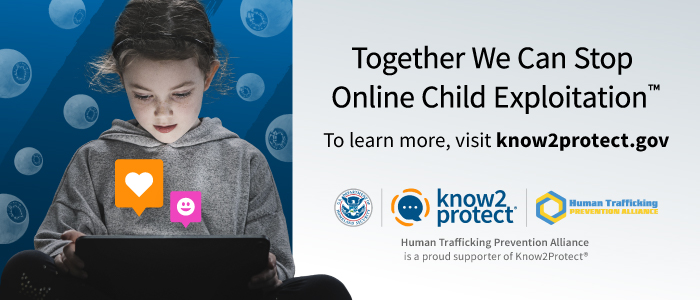
by janetlombardo | Jun 5, 2025 | Press Release
FOR IMMEDIATE RELEASE
Human Trafficking Prevention Alliance Enters Strategic Co-Branding Agreement with DHS Know2Protect® Campaign
Sparks, NV — June 1, 2025 — The Human Trafficking Prevention Alliance (HTPA) is proud to announce a new co-branding agreement with the U.S. Department of Homeland Security’s (DHS) Know2Protect Campaign, marking a significant milestone in the fight against online child exploitation and human trafficking.
Through this agreement, HTPA is authorized to use the Know2Protect Campaign’s educational materials and visual assets, including the right to copy, display, and distribute official campaign materials containing the DHS Seal and various Know2Protect Campaign Trademarks. This collaboration empowers HTPA to amplify its outreach and educational efforts with trusted, government-backed resources that are proven to raise awareness and drive action.
“This collaborative opportunity represents a powerful alignment of mission and message,” said Janet Lombardo, Founder and CEO of HTPA. “By integrating Know2Protect’s authoritative materials into our programming, we can expand our impact and better equip communities to recognize, resist, and report online child sexual exploitation and abuse, as well as human trafficking.”
“Support and collaboration with organizations like the Human Trafficking Prevention Alliance and communities across the country are absolutely critical to our mission,” said Kate Kennedy, Know2Protect campaign director. “By working together, we can raise awareness, share trusted tools, and empower more families to protect children and teens from online threats. It takes all of us to build a safer digital world for the next generation.”
The license, authorized under DHS Delegation Number 10001 § II(B)(8) (April 28, 2014), and pursuant to 6 U.S.C. § 181 et seq., allows HTPA to use Know2Protect campaign materials under specific guidelines. As a formal supporter of the campaign, HTPA is committed to upholding the integrity and standards associated with the use of these materials and the Government Visual Identities.
The Know2Protect campaign is a national initiative designed to educate youth, caregivers, and trusted adults about online safety and the risks of exploitation. By joining forces, HTPA and DHS aim to extend the reach of this critical message and foster safer communities across the country.
For more information about HTPA’s programs and its collaboration with Know2Protect, please visit ht-prevention.org. For announcements on the release of HTPA-Know2Protect cobranded educational materials, follow HTPA on X at @HTPAlliance.

by janetlombardo | Oct 5, 2024 | Blog Post
As Generative AI continues to advance, we are confronted with an insidious threat: financial sextortion. This modern exploitation leverages AI’s capabilities to manipulate and extort individuals, posing serious ethical and financial risks. The ease of creating deepfakes has also led to an increase in cyberbullying. Victims, many children, are targeted with fake videos or images, leading to harassment, social isolation, depression and fear. Many children will never disclose these crimes out of fear of not being believed, even though the images or videos are fake.
More than ever our children, parents and caregivers must be equipped with skills to deal with online threats. We must take action by reducing the barriers so children feel they can go to a trust adult and ask for help. They need to know it is not their fault. As a community education partner with NCMEC, HTPA is equipped to provide age-appropriate education that will empower our youth to know how to respond to online blackmail and other forms of online exploitation.
In addition to education, we at HTPA are advocating for safer laws. We believe we can all do something to eradicate online exploitation. Join us in this fight: get educated, become a Champion of Change. #endchildexploitation

by janetlombardo | Sep 19, 2024 | Press Release
Press Release
For Immediate Release
HTPA ANNOUNCES PARTNERSHIP WITH NCMEC TO LAUNCH COMMUNITY EDUCATION PROGRAM
Sparks, NV – September 19, 2024 – The Human Trafficking Prevention Alliance (HTPA) is proud to announce a new partnership with the National Center for Missing & Exploited Children (NCMEC). HTPA has joined the NCMEC Community Education Program aimed at providing age-appropriate prevention and safety programming to Northern Nevada. This initiative will also offer vital services and support to families, the public, law enforcement, and other professionals.
The Community Education Program is designed to:
- Reduce Child Sexual Exploitation: Implementing educational programs that teach children and families about the dangers of exploitation and how to stay safe.
- Prevent Future Victimization: Providing ongoing support and resources to prevent children from becoming victims of trafficking and exploitation.
“We are thrilled to partner with NCMEC to expand our efforts in protecting children and supporting families,” said Janet Lombardo, Founder and CEO at HTPA. “This collaboration will enhance our ability to educate the community and provide critical resources to those in need.”
NCMEC has been a leader in child protection for over 30 years, and this partnership will leverage their expertise and resources to further HTPA’s mission of preventing human trafficking and child exploitation.
For more information about the Community Education Program or to get involved, please visit ht-prevention.org or contact info@ht-prevention.org.
For more information on the National Center for Missing & Exploited Children please visit https://www.missingkids.org/
About HTPA
The Human Trafficking Prevention Alliance (HTPA) is a non-profit organization dedicated to preventing human trafficking and child exploitation through education, advocacy, and support services. Our mission is to create a safer world for children and families.

by janetlombardo | Feb 17, 2024 | Blog Post
Protecting Our Children in the Digital Age: Safeguarding from Online Predators
by Janet Lombardo
Founder, CEO – HTPA
Executive Summary:
The internet offers immense opportunities for children, but it also harbors hidden dangers. Predatory individuals may exploit children online through various means, including child sexual abuse material (CSAM), child exploitation, and sextortion. This whitepaper aims to equip parents with the knowledge and tools to effectively safeguard their children from such threats. It defines key terms, outlines the nature of these dangers, and presents actionable strategies for creating a safe online environment for children.
Defining the Threats:
- Child exploitation: Any act or series of acts that involve a child being used for someone else’s gain or satisfaction, including sexual, economic, or psychological exploitation.
- CSAM (Child Sexual Abuse Material): Any visual or auditory content depicting the sexual abuse of a child, including pornography, exploitation, and trafficking.
- Sextortion: Coercing someone into sexual acts or sharing explicit material by threatening to expose them or harm them.
Understanding the Predators:
Online predators often use manipulative tactics to gain children’s trust and exploit their vulnerabilities. They may create fake online personas, offer gifts or promises, and exploit emotional needs or curiosity. Recognizing these tactics is crucial to preventing victimization.
Building a Safety Net:
Open Communication: Foster open and honest conversations with your children about online safety, emphasizing trust and understanding. Create a safe space where they can freely discuss their online experiences and concerns.
Tech Savvy Parents: Familiarize yourself with the platforms your children use, understand their features and privacy settings, and set clear boundaries for their online activities.
Digital Citizenship: Educate your children about responsible online behavior, including respecting others, protecting their privacy, and avoiding sharing personal information.
Monitoring and Filtering: Consider using parental controls and monitoring tools to help filter harmful content and track online activity. However, remember that these tools are not foolproof and open communication remains paramount.
Spotting the Signs: Be aware of potential red flags like changes in behavior, secretive online activity, emotional distress, or withdrawal from family and friends.
Empowering Children:
Safety Skills: Teach your children how to identify suspicious online behavior, block unwanted contacts, and report inappropriate content. Encourage them to be critical of online information and to always prioritize their safety.
Trust and Reporting: Emphasize that they can come to you with any concerns without fear of judgment or punishment. Create a safe environment where they feel comfortable reporting suspicious activity or harmful situations.
Seeking Support:
Cybersecurity Resources: Leverage resources from law enforcement agencies, cybersecurity organizations, and child protection NGOs.
Mental Health Support: Provide access to mental health professionals if your child experiences anxiety, fear, or trauma related to online experiences.
Conclusion:
Protecting children from online predators requires a proactive and collaborative approach. By building a safe environment, cultivating open communication, and empowering children with essential skills, we can ensure that the digital world remains a place of opportunity and exploration, not of exploitation and harm.
Additional Resources:
Human Trafficking Prevention Alliance: https://www.ht-prevention.org
National Center for Missing & Exploited Children: https://www.missingkids.org/home

by janetlombardo | Oct 30, 2023 | Blog Post
Did you know?
According to the 2023 Trafficking in Persons Report from the Office to Monitor and Combat Trafficking in Persons, boys represent the fastest-growing segment of identified human trafficking victims. UNODC’s 2022 Global Report on Trafficking in Persons, released in January 2023, notes that the percentage of boys identified as victims of human trafficking more than quintupled between 2004 and 2020 – a much larger increase than for men, women, or girls. The same report notes males (including boys and men) account for 40 percent of all identified victims of human trafficking. While women make up about twice the percentage of identified trafficking victims as men (42 % to 23 %), the percentage of trafficking victims who are boys and girls is almost the same (17 % and 18 %).
Males are less likely than females to say they are victims of human trafficking, even though they are just as likely to be trafficked. Men are more likely to think of themselves as being unlucky or gullible, rather than exploited.
What can we do?
Raise awareness! Promote change in your community and help victims come forward. Taking the power away from predators is key.





